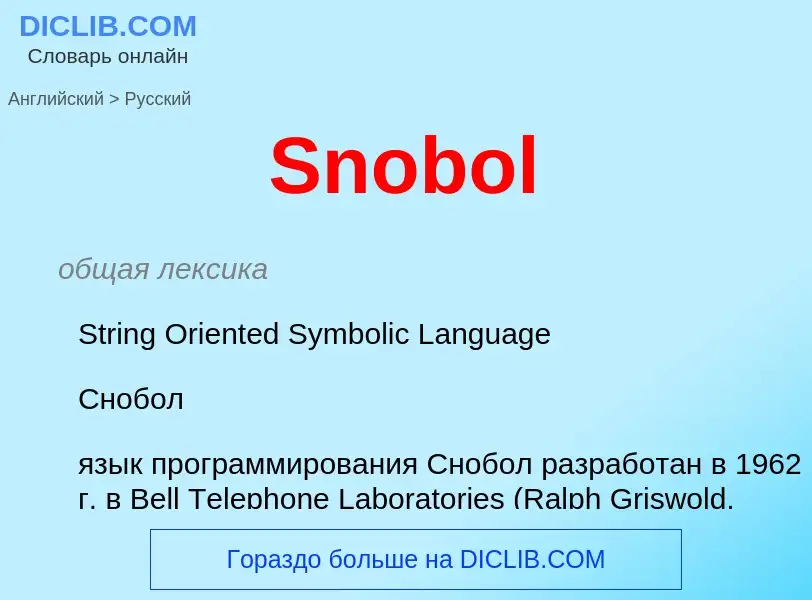Translation and analysis of words by ChatGPT artificial intelligence
On this page you can get a detailed analysis of a word or phrase, produced by the best artificial intelligence technology to date:
- how the word is used
- frequency of use
- it is used more often in oral or written speech
- word translation options
- usage examples (several phrases with translation)
- etymology
SNOBOL - translation to English
общая лексика
String Oriented Symbolic Language
Снобол
язык программирования Снобол разработан в 1962 г. в Bell Telephone Laboratories (Ralph Griswold, David Farber, Ivan Polonsky). Символьный язык, ориентированный на обработку строк текста. Дальнейшее развитие: Snobol-2 (1964 г.), Snobol-3 (1966 г.) и наиболее популярная редакция - Snobol-4 (1969 г.). На начало 1980-х годов имелось более 50 реализаций его интерпретаторов. Оказал влияние на ряд других языков
существительное
общая лексика
язык программирования ЭВМ для манипулирования цепочками или строками символов
синоним
Wikipedia
SNOBOL ("StriNg Oriented and symBOlic Language") is a series of programming languages developed between 1962 and 1967 at AT&T Bell Laboratories by David J. Farber, Ralph E. Griswold and Ivan P. Polonsky, culminating in SNOBOL4. It was one of a number of text-string-oriented languages developed during the 1950s and 1960s; others included COMIT and TRAC.
SNOBOL4 stands apart from most programming languages of its era by having patterns as a first-class data type (i.e. a data type whose values can be manipulated in all ways permitted to any other data type in the programming language) and by providing operators for pattern concatenation and alternation. SNOBOL4 patterns are a type of object and admit various manipulations, much like later object-oriented languages such as JavaScript whose patterns are known as regular expressions. In addition SNOBOL4 strings generated during execution can be treated as programs and either interpreted or compiled and executed (as in the eval function of other languages).
SNOBOL4 was quite widely taught in larger U.S. universities in the late 1960s and early 1970s and was widely used in the 1970s and 1980s as a text manipulation language in the humanities.
In the 1980s and 1990s, its use faded as newer languages such as AWK and Perl made string manipulation by means of regular expressions fashionable. SNOBOL4 patterns subsume BNF grammars, which are equivalent to context-free grammars and more powerful than regular expressions. The "regular expressions" in current versions of AWK and Perl are in fact extensions of regular expressions in the traditional sense, but regular expressions, unlike SNOBOL4 patterns, are not recursive, which gives a distinct computational advantage to SNOBOL4 patterns. (Recursive expressions did appear in Perl 5.10, though, released in December 2007.)
The later SL5 (1977) and Icon (1978) languages were designed by Griswold to combine the backtracking of SNOBOL4 pattern matching with more standard ALGOL-like structuring.

